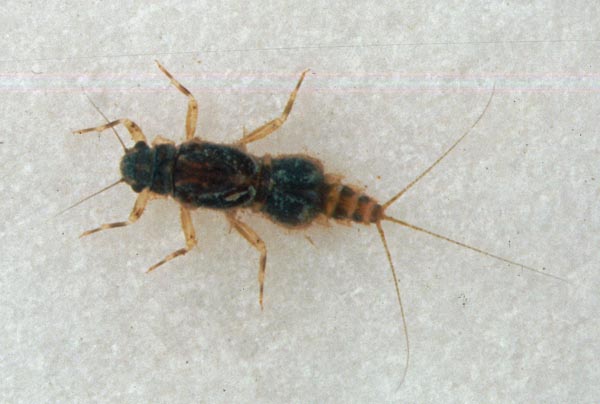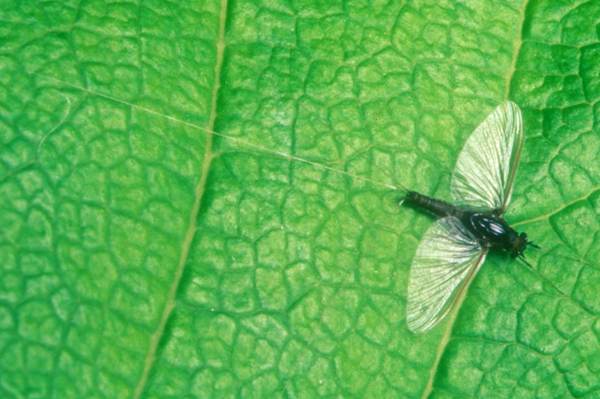Trees Birds Mammals Fish Amphibians Reptiles
Wild Algarve
Bookshop
Caënis species - Anglers' Curse
Phylum: Arthropoda - Class: Insecta - Order: Ephemeroptera - Family: Caenidae

Note: strictly the genus name is Caënis, but as people searching for information on the internet do not generally include accents (diacritical marks) such as the umlaut above the character ë, we have used the easier-to-type Caenis in the main text of this page.
The smallest of British up-winged flies, the Caenis flies
are often referred to as the Angler's Curse. Caenis nymphs crawl among the silt and detritus on the
river or lake bed, and they are often covered it bits of debris that act
as camouflage - as in the example shown here.
Caenis nymphs live on the beds slow flowing stretches of rivers and in
the shallow areas of most kinds of stillwaters. In general the lower the flow and the more leaf litter falls into the water, the more suitable the habitat is for these silt-loving insects. Identifying Caenis nymphs to species level is difficult, and for some species it is necessary to use a microscope to examine fine details that are not clearly visible to the naked eye. Caenis horaria, pictured above, is an exception: it has a pronotum (the plate-like cover of the first segment of the thorax) that is broad at the front and much narrower at the rear, and the lateral margin of the pronotum is noticeably concave.

Dun of Caenis rivulorum
So what? Nothing... except that if you start to take an interest in the flies you are trying to imitate it is inevitable that you will wonder why professional entomologists have divided the Caenis flies into numerous species. (At least six Caenis species are fairly common in Britain and Ireland, and another three less widespread are known to occur in certain localities.)
A small Pheasant-tail Nymph inched across the silty margin of a pool in order would imitate a Caenis nymph foraging for vegetable debris, but in my experience there is little justification for doing so. A tiny artificial nymph fished in the surface film is worth a try at the beginning of a Caenis hatch, but once these little flies begin emerging in their millions then hoping that a trout will choose your minute morsel rather than any of the myriad others seems a hopeless strategy. Why not just watch? Or maybe try a very large fly in the hope that a greedy trout will fancy a change of diet!

Dun or subimago
At the dun stage most of the Caenis species found in Britain and Ireland all look much of a muchness. All retain three tails in the winged-insect stages of their lifecycles. Some emerge in the mornings
and others around dusk. They leave the water as duns, fly to the nearest bush, rock or other object (such as a person!) on dry land and immediately shed another skin to become spinners. This is an amazing sight, and if you have never seen an up-winged fly transpose from dun to spinner you know what to do: stand beside a silty lake, canal or slow-flowing river during a Caenis hatch and your coat sleeves will be your 'wildlife movie screen'.
Caenis duns can be copied by all-white imitations. The challenge is to ties flies small enough to be credible representations of these tiny upwinged flies, and sizes 22 to 26 hooks are too small for most people to cope with. The lovely Caenis imitations shown here were tied by that wonderful Irish flydresser Alice Conba.

Spinner or imago
Caenis spinners are generally very similar to the duns, but their
tails are much longer and their wings more transparent.
At times there can be so many Caenis emerging as duns and returning to
the water as spinners that flyfishers find it hopeless trying to tempt
trout with a matching imitation. However, during relatively sparse hatches
a small, white or cream-coloured fly will sometimes do the trick. There is no need to have separate patterns for matching the dun and the spinner, and certainly no reason for differentiating between the various Caenis species. This is a case of one size and one pattern fits all.
Excited by rivers and streams? So are we, and we're pretty sure you would find the Winding River Mystery trilogy of action-packed thrillers gripping reading too. Dead Drift, Dead Cert, and Dead End are Pat O'Reilly's latest river-based novels, and now they are available in ebook format. Full details on our website here...
Buy each volume in ebook format for only £2.47 on Amazon... Paperbacks also available on Amazon at £6.95 each. All proceeds go towards keeping the First Nature website online.
Please Help Us: If you have found this information interesting and useful, please consider helping to keep First Nature online by making a small donation towards the web hosting and internet costs.
Any donations over and above the essential running costs will help support the conservation work of Plantlife, the Rivers Trust and charitable botanic gardens - as do author royalties and publisher proceeds from books by Pat and Sue.